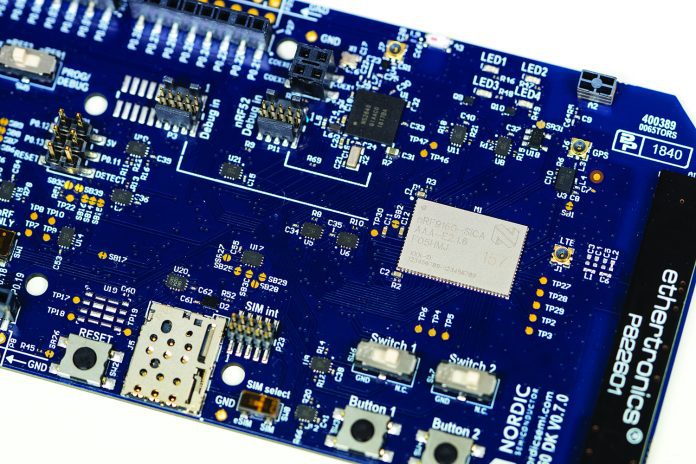Chip maker Nordic Semiconductor is combining low-power long- and short-range IoT connectivity technologies in hardware and software, at developer level, for solution makers to run the pair together in test applications.
Nordic has two hybrid IoT offers, in the form of its nRF9160 developer kit and its Thingy:91 gateway platform. It is likely, although not confirmed, the Norway-based firm will integrate multi-mode short and long-range low-power radios into a single piece of silicon shortly.
“The big push is to combine these solutions,” remarks SveinEgil Nielsen, the company’s chief technology officer. Nordic provides multi-mode short-range and long-range products separately from each other. Its headline nRF52840 system-on-chip (SoC) supports Bluetooth Low Energy (BLE), Zigbee, and Thread, as well as proprietary 2.4GHz systems. Its cellular-based nRF9160 system-in-package (SiP) offers both LTE-M and NB-IoT.
The company has just announced a deal with US outfit Qorvo for hybrid short-range modules, pairing BLE and UWB (see page 31). The single-board developer kit for the nRF9160 SiP is designed for developers “to get their cellular IoT applications working”; it is pre-certified and affordable, says Nordic.
The Thingy:91 is a “full-blown ready-to-go gateway”, which customers are already using as an off-the shelf module for early product designs, which can be swapped-out for the constituent parts if the designs get made. Both feature the dual-mode cellular nRF9160 SiP and multi-protocol short-range nRF52840 SoC.
“It was obvious to go with both short and long-range IoT when offering something for customers to play with. We are very strong in both; we are fortunate we can put them together. We are a one-stop shop, effectively, and it makes sense to leverage those assets,” says Nielsen.
He adds: “It would not be wrong to think that in the future they would be even more integrated. But for now, the most important thing is that developers can get them to work together. Whether or not they do so in monolithic or integrated silicon is less important. The technology has to work together.”
Meanwhile, Nordic has also released a companion software development kit (SDK) for developers to evaluate and test its short-range nRF52840 SoC and cellular nRF9160 SiP in hybrid IoT setups. Customers can use sample applications to quickly cycle through proofs, prototypes, and finished products.
The nRF Connect kit is based on the opensource Zephyr real-time operating system (RTOS), driven by the Linux Foundation. The Zephyr system is designed for resource-constrained embedded IoT devices, to abstract away hardware and scheduling complexity for developers.
Bjørn Kvaale, in Nordic’s technical support group, comments: “As applications increase in complexity and require more processing threads and multi-protocol solutions become standard, an RTOS can help manage design complexity. It helps speed development and simplify collaboration.”
The SDK is part of Nordic’s broad- er nRF Connect portfolio for short- and long-range IoT, which includes developer tools for evaluating the company’s cellular IoT and BLE products, as well as interplay between them.
Note, this article is taken from a new Enterprise IoT Insights editorial report, out now, on the combination of low-power short- and long-range communications technologies in hybrid IoT systems (see cover image below). Click on the image below for the full report; a webinar on the same subject, including panellists from ABI Research, the Bluetooth SIG, Nordic Semiconductor, Sigfox, and The Things Network, is scheduled for today (July 9), also. Register here to attend the webinar; a recording will be available after.


